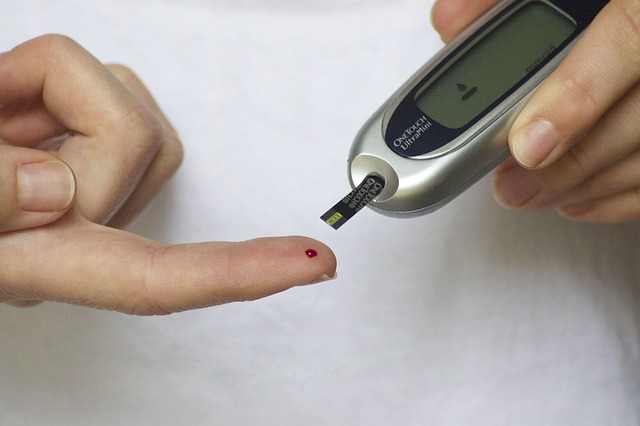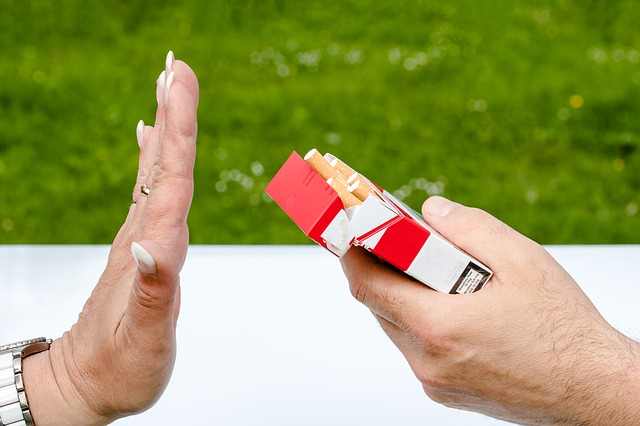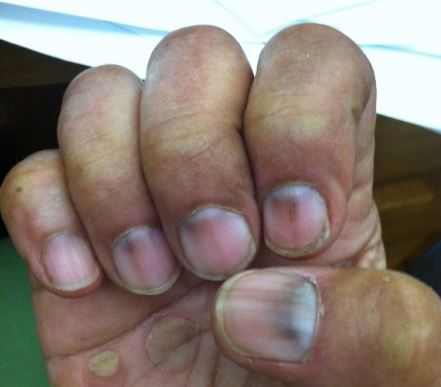Discolored nails and nail beds, or fingertips will make your fingers look unnatural. While a color like light yellow is easy to mask, a purple one is quite serious and dark – and very noticeable.
What causes purple nail beds? What do they mean?
Here are the possible causes and cures for purple discolored nail beds and fingertips.
Some illnesses cause specific characteristics, marks, or colors to appear on the fingernails. Purple nail beds are often an indication of different illnesses, including lack of enough oxygen in the body.
What does it mean when your nail beds are purple?
Cyanosis is the medical term used to describe the bluish hue that appears underneath the fingernails. The condition can be because of hypoxemia, which indicates the presence of a low amount of the oxygen-carrying hemoglobin, which is normally found within your red blood cells.
Traditionally, the arterial blood should be flush with the oxygenated cells, and this makes the blood to appear bright red. But, when there is a decline in the oxygen levels, the blood ends up having very few red blood cells, and will thus begin to turn blue-red.
Given that the skin is a combination of the color of blood as well as skin pigmentation, cyanosis, is, therefore, an indicator that there is a deficiency of oxygenated cells, leading to the purple nail beds.
When the temperatures are very cold, they can temporarily slow your blood flow to the various parts of the skin, and this will lead to the bluish color, which should go away when you become warm. As explained above, purple nail beds can be an indication that you have certain disorders, hence the need to seek medical attention.
For Raynaud’s disease, your toes and fingers will blanch and then turn blue before they become painful or numb upon being exposed to cold temperatures.
In this case, the major problem is the oversensitivity of the nerves that are controlling the flow of blood through the various arteries supplying blood to the peripheral parts of your body such as the nose, fingers, and toes.
When chronic cyanosis occurs, it could be an indication that a person has specific lung problems such as asthma and pulmonary embolism. High altitudes, heart problems, and reactions to particular medication like minocycline, relied upon when treating bacterial infections, as well as some sedatives.
You need to be aware that ingesting colloidal silver may also lead to the skin becoming slate-blue colors as well as causing purple nail beds.
If you realize that the bluish nails have not been caused by a reaction to the cold temperatures, it is recommended that you see your physician for a comprehensive medical checkup, which will assist in determining the cause.
The physician may perform a rapid blood-gas analysis, which is meant to measure the amount of oxygen that is present in the blood. A series of tests may also be conducted to check the condition of your lungs and heart.
What causes purple nail beds?
Why are my nail beds purple? Anemia, diabetes, simple discolorations, and even smoking can cause your nail beds to turn purple or change their color.
In some people, nail beds change color as well as fingertips. You may also get purple fingers with this problem. Here are the causes.
1. Purple fingernail beds when cold
Poor circulation is one of the known causes of purple nail beds. If you notice that the nails are purple and tingly at the same time, there is a chance that they are not getting enough blood.
When your blood contains lots of oxygen, it will be bright red. Dark blood is the blood that is not receiving enough oxygen.
2. Anemia
When a person is described as being anemic, it implies that their blood has very low amounts of iron. If this is the case, there is a very high probability that such a person will develop purple nail beds within no time.
It is something that comes about because the blood is not oxygenated, as it should. You can address this problem by taking vitamin C and iron supplements each morning, which assists with the absorption of the required iron.
3. Diabetes

It is normal for nails to appear pale, but with a bluish hue around the nail beds when your body is unable to metabolize sugars as is required of it. The problem can be attributed to diabetes, which is characterized by the deficiency of insulin in the body.
When a person has diabetes, there is always the possibility that their pancreas and liver will start to malfunction, and this means that they will stop producing the enzymes that are relied upon by the body to assist in regulating the blood glucose levels.
Your physician may need to perform a series of tests just to be sure of this, but in the meantime, it is recommended that you consider reducing your sugar intake.
4. Anorexia
Individuals suffering from an eating disorder will often be very secretive on matters of their thoughts as well as behaviors. However, certain physical signs will start to become evident with time if a person has an eating disorder that is affecting their overall wellbeing.
Unfortunately, when the physical signs start becoming obvious, it implies that the individual in question has already placed their health at risk. Even though many anorexics are not able to see it, these people require medical attention and should be encouraged to seek it immediately.
Anorexia: Physical Signs
A person suffering from this condition often runs the risk of starving him or herself. Studies have shown that those suffering from severe anorexia often see to welcome the state that their body is in, meaning that the health risks of this condition are similar to starvation.
- Dry hair, skin, and nails, severe weight loss, muscle loss, and the presence of brittle bones are all symptoms associated with anorexia.
- Experts have observed that anorexics could become very sensitive to cold, and this may mean that they will feel cold all the time, even when sunny, with blue toes, lips, and or fingers accompanying the cold feeling.
In some cases, anorexics may begin sprouting white hairs, which are often referred to as lanugo. The white hairs sprout because their bodies are attempting to insulate themselves, given that there is no fat in the body.
Damage to the kidneys, liver, and heart may also come about when a person has a severe case of anorexia, and this may ultimately lead to their demise.
5. Smoking

For people who smoke regularly, do not be surprised to find yourself having purple nail beds.
The purple color on the nail beds comes about when your body becomes deprived of any oxygen, and therefore starts taking it from other areas of the body such as the fingers.
6. Injuries and bruises
If you happen to notice that only a single fingernail has become discolored, then it could mean that you have a broken blood vessel, or have recently sustained an injury on your fingernail.
Such an injury will prevent the blood from flowing as it normally does, and the resulting condition is called a subungual hematoma.
Even though this condition sounds serious, you should not get worried as this only mean that there is a bruise under the fingernail. You can make a small hole on your nail, and this will assist in relieving any pressure that is present. However, it is not recommended that you do this as it could expose your fingernail to numerous infections.
Home remedies for purple nail beds
Many people suffer from the problems associated with having purple nails. The condition is common among both men and women and can be a significant source of embarrassment.
Some of the factors known to cause this condition include smoking, poor lifestyle habits, as well as fungal infections. You can use the following home remedies to deal with the purple nail beds.
Lemon
Naturally, lemon is a bleaching agent, which can be used to deal with discoloration occurring on your nails. Additionally, lemon has been known to work as a great astringent.
What to do at home
- Take a bowl and fill it to the halfway mark with lemon juice. Take the fingers with the purple nail beds and soak them in the lemon juice for at least fifteen minutes. You will then need to take a soft toothbrush and use it to scrub the nail beds. Once done, take some lukewarm water and use it to rinse your hands, before you can apply a moisturizing lotion on your fingers, which will assist in replenishing your moisture content. You must repeat this two times each day until you notice an improvement.
- Alternatively, consider using the lemon essential oil. What you need to do is take a small amount of lemon essential oil, place it in a shallow bowl, fill it with water, and then dip your fingers in the solution for a few minutes. You will then need to scrub the nails using a very soft toothbrush for at least two minutes. The process should be repeated two times each day for a few weeks to allow the nail beds enough time to regain their natural color.
Hydrogen peroxide
Hydrogen peroxide comes with important whitening properties, which are known to work wonders on purple nail beds. However, you have to ensure that you only use a solution that has a three percent concentration.
What to do at home
- Take hydrogen peroxide and pour three teaspoons into half a cup of water, and then proceed to ensure that they mix properly. It is recommended that you take the affected fingers and dip them in the solution for at least two minutes, before taking a soft toothbrush and using it on all the affected fingers. Once you have completed this, make sure to rinse the fingers using warm water. You may have to repeat the process at least once a week for a month.
- If the nail beds are stubborn, you have to take the peroxide and apply it to your fingers directly. Pick a soft toothbrush and use it on the affected fingers.
Important to note: Hydrogen peroxide is capable of dehydrating the nails, and as such, it will be essential to make sure that a moisturizing lotion is used on your fingers as soon as possible.
Baking soda
Baking soda is utilized on purple nail beds due to its exfoliating and bleaching properties, which assist in removing even the most stubborn stains.
What to do at home
- Take two teaspoons of baking soda and combine them with hydrogen peroxide (three percent) in a small mixing bowl. Take some cotton swabs and use them to apply this mixture on the nail beds that are affected. Once applied, you will need to leave the solution there for at least four minutes before using warm water to rinse all your fingers. The process should be repeated every eight weeks.
- Alternatively, you can combine a single teaspoon of baking soda, one of olive oil, and a single teaspoon of olive juice to come up with a fine paste. Obtain a soft toothbrush and use it to apply the mixture on all the nail beds. When the application is complete, allow it to stay there for at least five minutes before rinsing the paste off with warm water. The remedy application process should be repeated after two weeks.
Whitening toothpaste
The same toothpaste that you use each morning to whiten your teeth will also come in handy when you want to get rid of the purple nail beds.
If the discoloration is not too much, it is recommended that you use mild toothpaste, which contains a whitening ingredient, and which contains hydrogen peroxide.
What to do at home
- Gently apply a small amount of whitening toothpaste on the nails and allow it to stay there for a minimum of ten minutes.
- Locate a soft toothbrush and use it to scrub the nails. Always ensure that you are gentle to avoid injuring yourself.
- Soak some cotton balls in warm water, and then use it to clean the toothpaste from the affected nails.
- It is recommended that you try to repeat this process a minimum of three times each week, for the next thirty days, to record the best results.
Denture cleaning tablets
Denture cleaning tablets come in handy when dealing with nails that have been discolored, as well as purple nail beds.
Citric acid and sodium bicarbonate are the two ingredients that are commonly found in the denture cleaning tablets, and which you can use when you want to remove stains from your fingers.
What to do at home
- Obtain three denture cleaning tablets and proceed to dissolve them in a single bowl that contains lukewarm water
- You will then need to take the nail beds that have been affected, and soak them in this solution for at least ten minutes
- Take a towel and gently pat the nails dry, before you can apply moisturizer on the hands
- The process should be repeated three times each week for three months
Tea tree oil
If a fungus is the cause of the nail beds becoming purple, you have to make sure that you try tea tree oil, as it is the best remedy for this kind of problem.
Naturally, tea tree oil is a fungicide that contains antimicrobial and antiseptic properties, which you can use to fight infections, as well as restore the natural colors of the nails.
We highly recommend Essential Oil Labs Tea Tree Oil (Check price on Amazon)
What to do at home
- Take an eyedropper and use it to apply the pure tea tree oil to the affected nail beds. Allow the essential oil to remain there for a few minutes, and then use lukewarm water to rinse it off. Try to repeat this application at least two times each for the next few months, until improvement has been noticed.
- Take equal amounts of olive and tea tree oil and combine them to come up with a solution. You will need cotton balls for use in applying the solution to affected nails. The application should be made daily for a few weeks.
Apple cider vinegar
ACV contains acetic and malic acids, which assist in eliminating the discoloration that is forming on your nail beds. Additionally, it also comes with critical antifungal properties, which are known to treat all kinds of nail infections that may lead to discoloration taking place.
Apple cider vinegar can also help in strengthening and stimulating the growth of your nails.
What to do at home
- Measure half a cup each of lukewarm warm and apple cider vinegar
- Take the affected nail beds and soak them in this solution for a minimum of twenty minutes
- Use a soft towel to pat the fingers dry
- The application should be made at least three times a day for the next four weeks, which will help treat any infections present, as well as eliminate the purple color.
Listerine
It is an excellent remedy that you can use to deal with discolored nail beds, where the discoloration has been brought about by a fungal infection.
Listerine comes with important ingredients such as thymol, menthol, and methyl salicylate, all of which contain vital antifungal properties.
What to do at home
- Take all your affected nails and place them in a hundred percent Listerine for at least thirty minutes. It is a process that you will need to repeat each day for at least one week, take a seven-day break, and then repeat it on the following week. You may notice that the skin around your nails may start becoming greenish, but the color will often go away on its own.
- Alternatively, consider combining equal amounts of vinegar and Listerine. Take all your affected nails and place them in this solution for at least thirty minutes. You have to ensure that you repeat the application each day until you begin to notice a change.
Orange peel
Orange peels contain high amounts of vitamin C, which will come handy when dealing with discolored nail beds.
What to do at home
- Take a fresh orange peel and use it to rub your nails at least three times each day. If you repeat the process each day, you should start to notice a positive change within a few weeks of repeated application.
- Alternatively, combine two teaspoons of orange peel powder (dried) and then add a small amount of water to it to come up with a thick paste. Take this paste and gently apply it on all the nail beds that are affected, before ensuring that you leave it there for a minimum of ten minutes. A soft toothbrush will come in handy in helping you remove the toothpaste from the nails. Once done, take some lukewarm water and use it to rinse your nail beds. It is important to ensure that you follow this remedy each day for at least two weeks.
Juniper berries
Traditionally, juniper berries have always acted as a strong disinfected that was relied upon to deal with discolored nails, which were as a result of fungal infections.
What to do at home
- Take a single teaspoon of crushed juniper berries and add them to one bowl of lukewarm water
- Take the nail beds that are affected and place them in this water for at least fifteen minutes
- Use lukewarm water to rinse your fingernails, and then apply a moisturizer to your hands
- It is recommended that you follow this remedy each day before you go to bed for the next few months
Once you have used these remedies, you will be ready to flaunt your beautiful and natural-looking fingernails within no time. In case you do not see any change after a few weeks, you should visit your doctor.
The purple looking nail beds could have been caused by an underlying medical condition, hence the need to have a doctor check you out.
Other cures for purple nail beds
If the purple color has been brought about by an injury, you can have surgery to remedy its condition.
Known as nail bed repair, the process involves removing foreign materials present in the area that is affected, tissue preservation, and taking proper care of the wound to ensure that it will not become infected, or start splitting.


